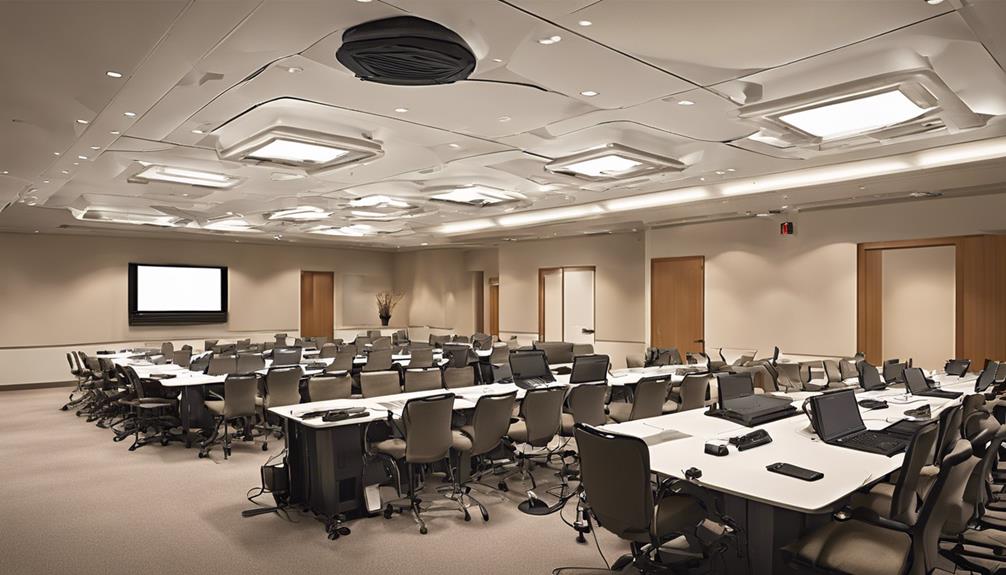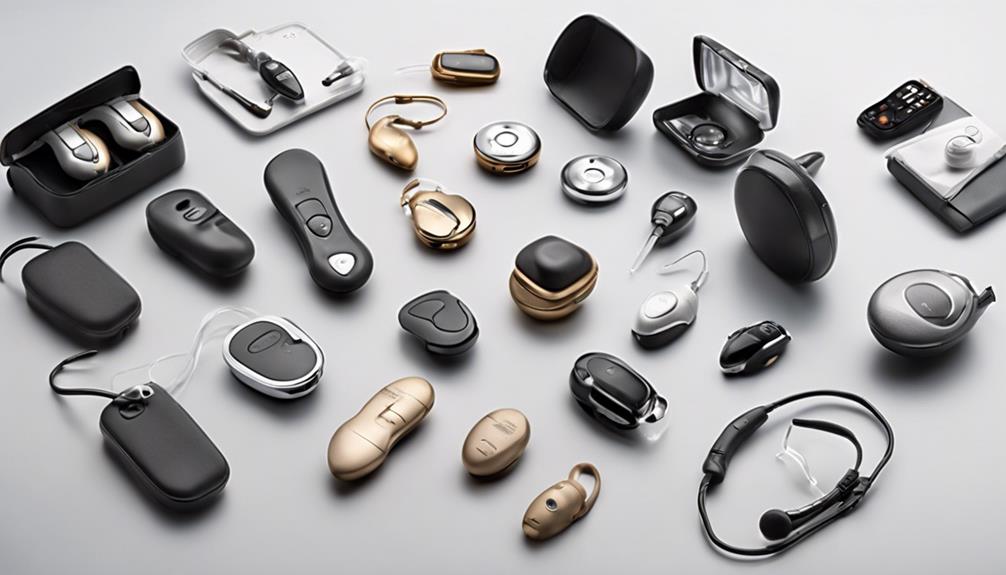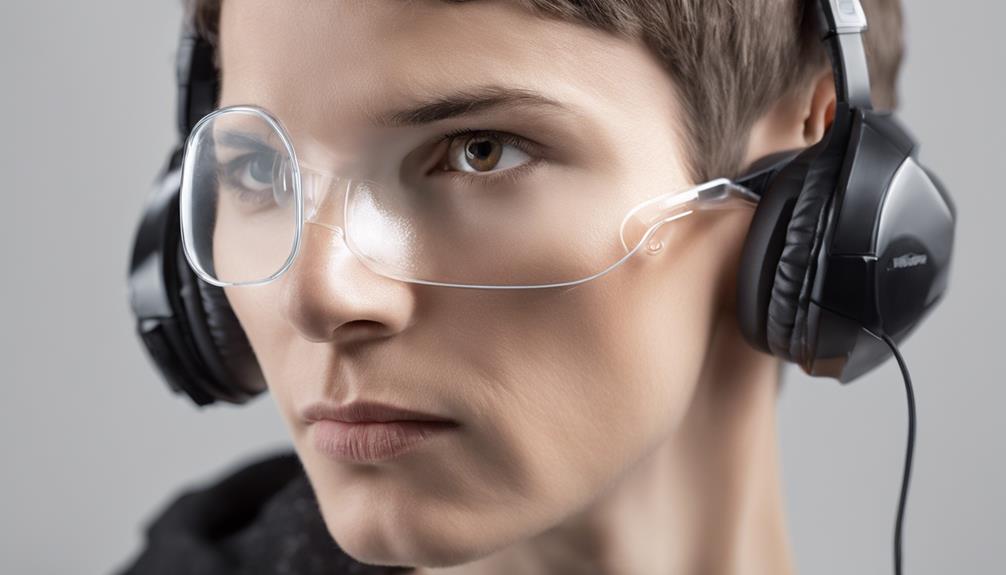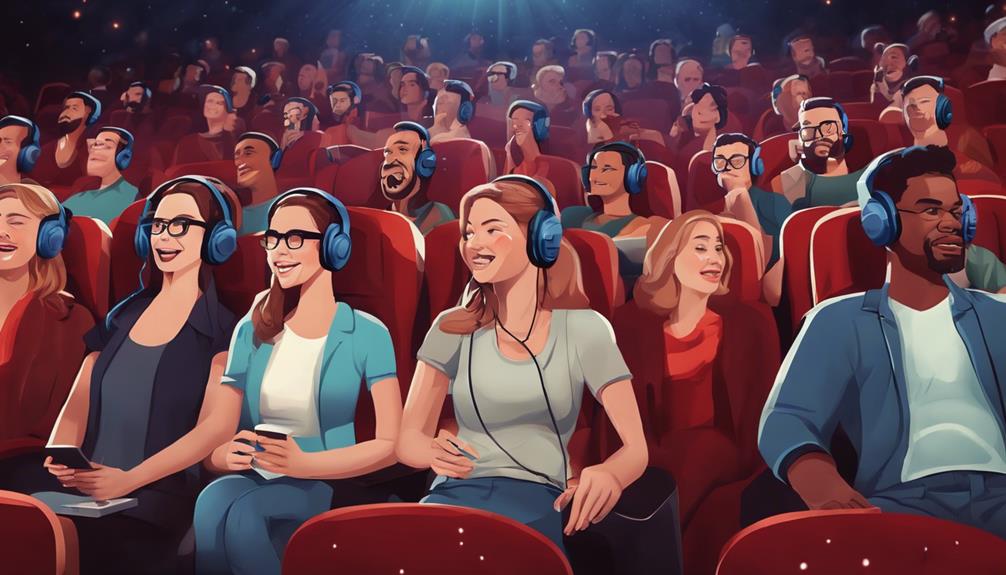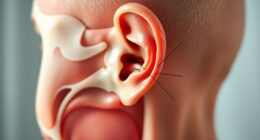When determining which assistive listening devices to choose for conference rooms, it is important to carefully consider various criteria. Factors such as the room size and participant needs all play a vital role in the decision-making process.
However, the real challenge lies in deciphering the plethora of options available and aligning them with the unique requirements of your meetings. Join us on this journey as we navigate the intricate landscape of assistive listening devices, shedding light on key considerations that will ultimately lead to an informed decision-making process.
Key Takeaways
- ALDs in conference rooms enhance accessibility and communication for individuals with hearing loss.
- Different types of ALDs like FM, infrared, and loop systems cater to diverse needs.
- Choosing the right ALD system involves evaluating room size, meeting requirements, and budget constraints.
- Proper installation, user training, and maintenance ensure effective ALD use and ADA compliance.
Understanding ALDs and Their Functionality
When selecting assistive listening devices (ALDs) for conference rooms, understanding their functionality is paramount to ensuring effective communication for all participants. ALDs are crucial tools for individuals with hearing loss, as they amplify or transmit sound to aid in overcoming challenges presented by background noise in meeting spaces.
Different types of ALDs, such as FM systems, infrared systems, and loop systems, cater to diverse needs and preferences. Not only do these systems enhance accessibility, but they also align with ADA requirements, ensuring that conference rooms are inclusive environments for all.
Benefits of ALDs in Conference Rooms
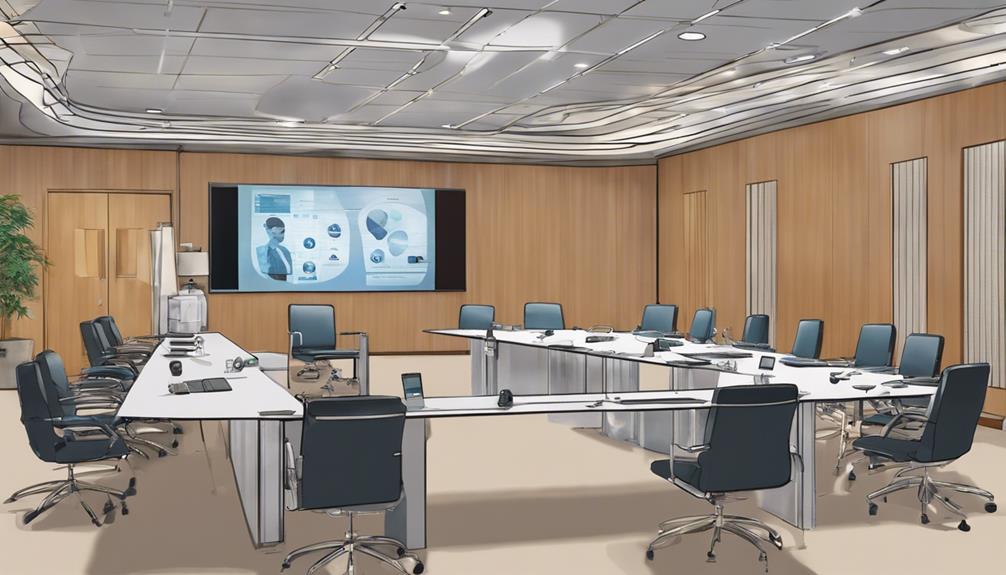
Understanding the benefits of ALDs in conference rooms illuminates their pivotal role in fostering enhanced communication and inclusivity for individuals with hearing impairments. When considering the advantages of Assistive Listening Devices (ALDs) in a conference setting, several key points come to light:
- Improved Listening Experience: ALDs enhance engagement and participation in meetings by providing clear sound for all participants, ensuring that individuals with hearing impairments can follow discussions effortlessly.
- Enhanced Inclusivity: The use of ALDs promotes inclusivity by ensuring compliance with accessibility standards and regulations, making conferences more welcoming and accommodating for all attendees.
- Positive Impact on Conference Dynamics: ALDs contribute to a positive impact on the overall conference experience by reducing background noise distractions and creating a more accessible environment for all participants.
- Compliance and Accessibility: Incorporating ALDs in conference rooms not only enhances the listening experience but also helps organizations comply with accessibility guidelines, showcasing a commitment to inclusivity and equal participation for everyone.
Types of ALDs for Conference Rooms
In conference rooms, a variety of ALDs, such as induction loop systems, infrared systems, FM systems, and Bluetooth systems, serve crucial roles in ensuring clear sound transmission to individuals with hearing impairments. Each type of ALD has its unique features and benefits for accommodating different hearing needs in conference settings. Here is a comparison of these ALDs:
| ALD Type | Technology Used | Key Features |
|---|---|---|
| Induction Loop | Magnetic field | Transmits sound directly to hearing aids with T-coils. |
| Infrared System | Infrared light | Offers secure, confidential transmission of sound. |
| FM System | Radio waves | Provides portable receivers for easy mobility. |
| Bluetooth System | Bluetooth | Allows direct connection to personal devices like smartphones. |
Understanding the characteristics of each ALD type is essential for selecting the most suitable system based on the conference room's layout, participant requirements, and budget constraints. ALDs play a vital role in ensuring all individuals can effectively participate in meetings and discussions, promoting inclusivity and accessibility in conference environments.
Factors to Consider When Choosing ALDs
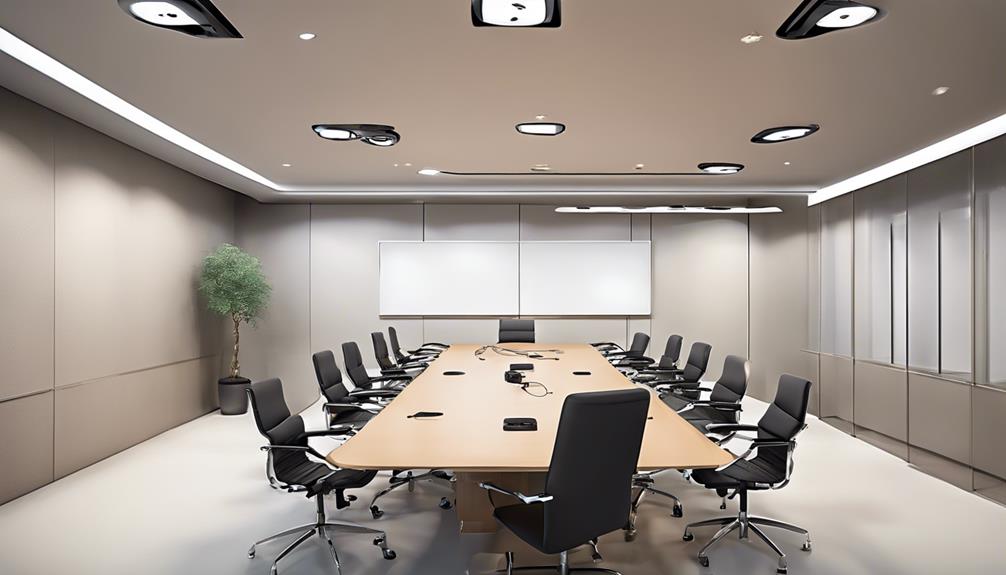
How can the size and layout of the conference room impact the optimal coverage of ALDs?
When choosing ALDs for conference rooms, several factors need consideration to ensure effective implementation and ADA compliance:
- Room Size and Layout: Evaluate the dimensions and setup of the conference room to determine the number and placement of ALD devices required for comprehensive coverage.
- Meeting Types: Consider the nature of meetings or events typically held in the room to select ALD features that cater to specific communication needs.
- Attendee Needs: Assess the number and requirements of individuals with hearing impairments attending conferences to choose suitable ALD technology offering the necessary support.
- Budget Constraints: Take into account budget limitations when selecting assistive listening equipment, ensuring a balance between cost-effectiveness and meeting accessibility requirements.
Installation and Usage of ALDs
To ensure effective implementation of Assistive Listening Devices (ALDs) in conference rooms, meticulous attention must be given to the proper installation and utilization procedures. Before meetings, testing the Wi-Fi Assistive Listening equipment is crucial to ensure its functionality. Staff members should undergo thorough training on ALD operation and troubleshooting to promptly address any issues that may arise. Providing clear instructions to participants on how to use the ALDs is essential for their effective utilization during conferences.
Optimal placement of the ALDs within conference rooms is key to maximizing their effectiveness. Placing the equipment strategically ensures that participants can benefit from enhanced sound quality and clarity. Additionally, regular maintenance tasks such as cleaning, battery replacement, and safe storage practices are vital for ALD upkeep. By adhering to these installation and usage guidelines, conference rooms can offer an inclusive and accessible environment for all attendees.
Additional Considerations for ALDs

When considering additional aspects of assistive listening devices for conference rooms, it's crucial to assess the room layout, ensuring proper coverage and accessibility.
Compatibility with existing audio systems and the potential need for user training are also essential factors to contemplate.
Room Layout Considerations
Considering the room size and layout is crucial in determining the optimal placement of Assistive Listening Devices (ALDs) for comprehensive coverage during conferences.
- Evaluate Room Size: Adjust the number of ALDs based on the room dimensions to ensure adequate coverage.
- Strategic Seating Arrangement: Place ALDs strategically to cover all seating areas effectively.
- Obstacle Assessment: Identify and eliminate obstacles that could interfere with the ALD signals.
- Enhance Accessibility: Ensure ALDs are easily accessible and visible to all participants for seamless use.
Taking these factors into account will help in maximizing the signal strength and clarity of ALDs in the conference room, providing an inclusive listening experience for all attendees.
Compatibility With Systems
For optimal integration with existing audiovisual systems in conference rooms, selecting Assistive Listening Devices (ALDs) that seamlessly interface with microphones, speakers, and other equipment is essential. When considering compatibility with systems, it's crucial to ensure that the ALDs can work effectively with various sound sources like microphones and audio outputs.
ALDs should be able to integrate seamlessly with different communication systems, such as the FM system, to deliver clear and reliable audio for all participants. By choosing ALDs that are compatible with multiple devices and setups, the overall conference room experience can be significantly enhanced.
Prioritizing compatibility when selecting assistive listening systems can lead to improved functionality and user satisfaction in conference room settings.
User Training Needs
Effective user training for Assistive Listening Devices (ALDs) in conference rooms is essential to ensure optimal utilization and functionality. When considering user training needs for ALDs, there are key aspects to cover:
- Training: Comprehensive instruction on ALD operation is crucial for users to fully benefit from the device.
- Volume Adjustment: Users should be trained on adjusting the volume to suit their hearing preferences.
- Troubleshooting: Understanding common issues and how to troubleshoot them ensures uninterrupted ALD usage.
- Ongoing Support: Providing continuous support and guidance post-training helps users make the most of ALDs in conference settings.
Recommendations for ALD Systems
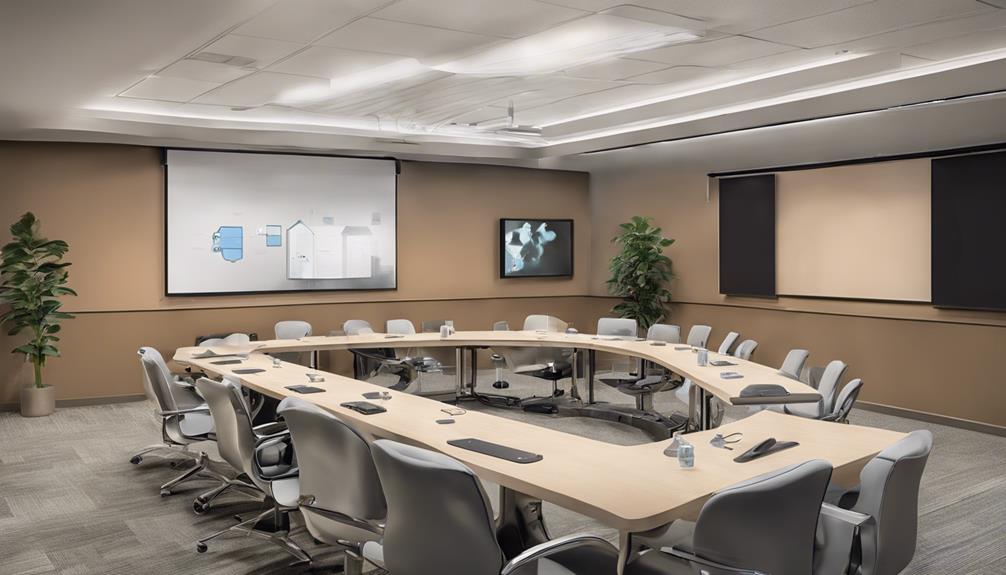
When considering recommendations for ALD systems in conference rooms, it's crucial to evaluate the types of ALD systems available and the key features they offer.
Understanding the variety of ALD system types such as FM, infrared, and loop systems can help in selecting the most suitable option.
Key features to consider include adjustable volume settings, compatibility with existing AV systems, and compliance with ADA regulations for accessibility.
ALD System Types
Discussing different types of ALD systems is crucial in selecting the most suitable assistive listening devices for conference rooms, ensuring optimal sound transmission for all attendees. When considering ALD system types, it's essential to understand the distinct features and benefits they offer:
- Induction Loop Systems: Ideal for telecoil-enabled hearing aids, providing direct sound to individuals.
- Infrared Systems: Ensure secure and private sound transmission in conference settings.
- FM Systems: Offer versatility with options for portable and fixed installations.
- Bluetooth Systems: Allow seamless connectivity with personal devices for individual listening needs.
Each system type caters to specific requirements, enhancing the overall conference experience for individuals with hearing impairments.
Key Features to Consider
Considering the specific requirements and optimal sound transmission for conference rooms, the key features to prioritize in assistive listening devices (ALDs) include room size, layout, acoustics, adjustable volume levels, device compatibility, ease of installation, durability, reliability, and customization options for enhanced functionality. When selecting an ALD system, it's crucial to ensure it meets the Americans with Disabilities Act (ADA) standards and can accommodate cochlear implants if needed. Below is a table summarizing the essential features to consider when choosing an ALD system for conference rooms:
| Key Features | Description | Importance |
|---|---|---|
| Room Size/Layout | Consider the space and arrangement for optimal coverage | High |
| Adjustable Volume | Accommodate varying hearing needs and preferences | Medium |
| Device Compatibility | Ensure seamless integration with different devices | High |
| Installation Ease | Simplify setup and operation for convenience | High |
Frequently Asked Questions
What Are the Four Major Types of Assistive Listening Devices?
When considering assistive listening devices, it's essential to understand the four major types: induction loop systems, infrared systems, FM systems, and Bluetooth systems.
Induction loop systems use magnetic fields for direct transmission to telecoil-equipped hearing aids.
Infrared systems rely on light signals, requiring line-of-sight.
FM systems utilize radio frequencies to broadcast sound, while Bluetooth systems provide wireless connectivity for clear audio transmission.
Each type offers unique benefits based on individual needs.
What Is the Most Commonly Used Type of Assistive Listening System in Educational Settings?
We often opt for induction loop systems in educational settings due to their direct transmission to telecoil-equipped hearing aids.
These systems effectively combat background noise and distance issues, enhancing accessibility for those with hearing impairments.
Cost-effective and ADA compliant, induction loop systems have become a staple in many institutions.
Their seamless integration with hearing aids equipped with telecoils makes them a popular choice for ensuring clear communication in educational environments.
What Are the Alternatives to Hearing Loop Systems?
Infrared systems serve as an alternative to hearing loop systems for ensuring clear sound transmission. These systems rely on light waves for secure, interference-free communication, making them ideal for confidential settings. They require line-of-sight between the transmitter and receiver, suiting specific room layouts.
Additionally, infrared systems can support multiple channels, facilitating language interpretation or simultaneous sessions in a single space. Their ability to provide privacy and flexibility makes them a valuable choice for various environments.
What Devices Are Available to Assist With Communication for Visually or Hearing Impaired?
When considering devices for visual or hearing impairments, options like personal FM systems with transmitters and receivers can aid communication. These systems provide clear sound in conference settings.
Additionally, neckloops with remote microphones offer personalized solutions by enhancing sound pickup for individuals with hearing impairments.
Utilizing such advanced technology ensures effective communication for those with visual or hearing challenges in various environments.
Conclusion
In conclusion, when choosing assistive listening devices for conference rooms, it's crucial to carefully consider the specific needs of attendees, the type of meetings held, and the available resources.
By evaluating the budget, seeking expert advice, and comparing features of different ALD systems, we can ensure optimal communication and inclusivity during conferences.
Remember, proper planning and proactive monitoring will lead to a more productive and inclusive conference experience.

